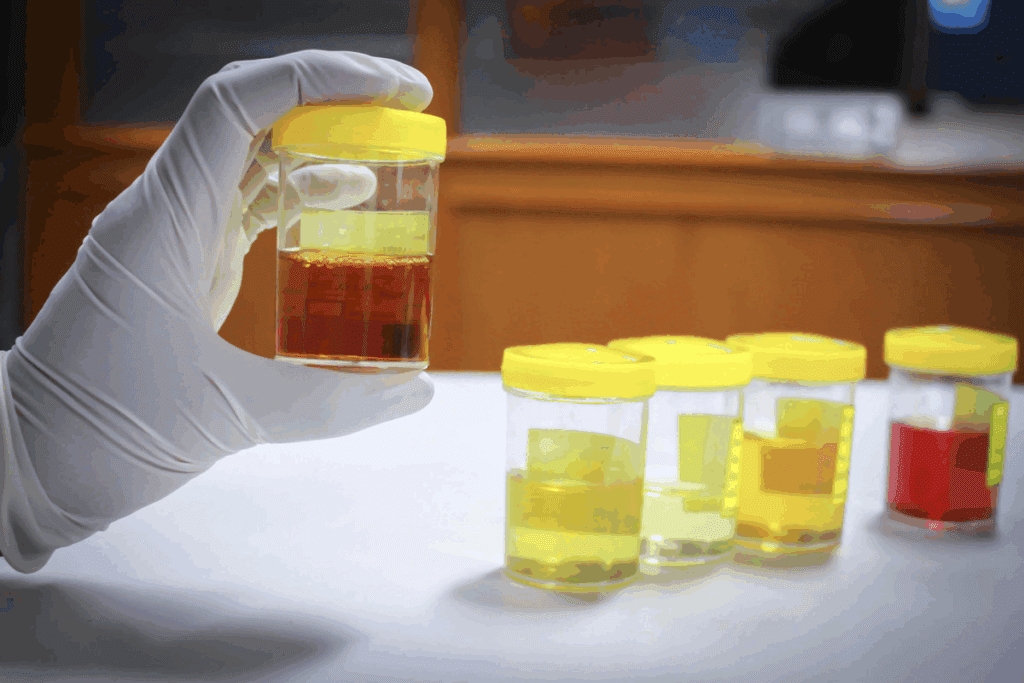Last Updated on October 31, 2025 by

Ever thought about what your urine appearance says about your health? Knowing how urine characteristics relate to urinary tract infections is key. It helps catch problems early and treat them fast.
We’ll look into how UTI urine color and look. This guide will help you understand these changes and what they mean. Some foods and meds can change urine color, but UTIs make specific changes. These changes are important signs of a problem.
At Liv Hospital, we aim to give our patients the best care. Spotting signs like cloudy or smelly urine can help you get the right medical help.

Normal urine color is a sign of good health. But what does it look like? Knowing what normal urine looks like is key to spotting health problems early.
Healthy Urine Appearance
Healthy urine is usually clear or pale yellow to amber. This color comes from a pigment called urochrome, made by the kidneys. Scripps Coastal Medical Center says normal urine is pale yellow to amber, based on how hydrated we are.
When we drink enough water, our urine is clearer and paler. As we get dehydrated, it gets darker and more concentrated. This change in color shows how well we’re hydrated.
Factors Affecting Normal Urine Color
Many things can change urine color. Hydration levels are a big factor, as we’ve seen. Other things include:
Knowing these factors helps us understand urine color changes. For example, eating beets will make your urine look red or pink.
| Factor | Effect on Urine Color |
| Hydration Level | Clear to dark yellow |
| Diet (e.g., beets, berries) | Red, pink, or purple |
| Medications | Various colors |
| B Vitamins | Bright yellow |
By knowing these factors and what’s normal for us, we can spot problems like UTIs sooner.

When a urinary tract infection (UTI) happens, it often changes the color of your urine. This change can be a sign of an infection. Knowing about these changes helps in catching and treating UTIs early.
First Visual Signs of Infection
The first signs of a UTI include changes in urine color. Cloudy or foul-smelling urine often means you have an infection. Medical News Today says UTIs can make urine look dark, cloudy, or even reddish, with blood traces.
These signs happen because the infection causes inflammation and bleeding in the urinary tract. Spotting these signs early can help you get medical help.
How UTI Affects Urine Appearance
A UTI can make your urine look different and unhealthy. The infection can cause:
These changes are not just about looks; they show you have an infection that needs medical care. By knowing how UTIs change urine, you can spot infections sooner and get treatment.
Cloudy Urine: A Primary UTI Indicator
A change in urine clarity, like cloudiness, often points to UTIs. When we have a UTI, our urine might look cloudy or turbid. This is a common sign.
What Causes Cloudiness in UTI
Cloudy urine in UTIs comes from white blood cells, bacteria, or other infection-related substances. Scripps Coastal Medical Center says, “Cloudy urine can be a sign of a UTI, as it may indicate the presence of white blood cells, bacteria, or other substances associated with infection.” Pyuria, or more white blood cells in urine, is a common reason for cloudiness.
The body’s fight against infection can also make urine cloudy. When the immune system sends white blood cells to battle bacteria, urine can look hazy or cloudy.
Differentiating UTI Cloudiness from Other Causes
Cloudy urine isn’t just a UTI sign. Dehydration, certain foods, or other health issues can also make urine look cloudy. For example, dehydration can make urine seem cloudy. Some foods or supplements can change how urine looks too.
“It’s important to consider other symptoms and see a healthcare professional for a correct diagnosis.”
To tell if cloudy urine is from a UTI or something else, look for other symptoms. These include painful urination, needing to urinate often, or stomach pain. A healthcare professional can do a urinalysis to check for infection and find the cause of cloudy urine.
Reddish or Pink Urine During UTIs
When you have a UTI, your urine might look reddish or pink because of blood. This can range from a light pink to a deep red, depending on how much blood is there.
Blood in Urine (Hematuria)
Hematuria is a common sign of UTIs. The blood can come from different parts of the urinary tract. Bacteria can cause inflammation and bleeding when they infect the tract.
The blood in urine can look different:
When to Be Concerned About Red Urine
While hematuria often means you have a UTI, it can also signal a more serious issue. You should worry if:
If you’re experiencing any of these symptoms, seeing a healthcare professional is key. They can help figure out what’s wrong and treat it.
Dark Yellow to Brown Urine with UTIs
UTIs can make urine turn dark yellow or brown. This change might worry you, but knowing why it happens is important. It helps us understand UTIs better.
Causes of Darkening
Dehydration is a big reason for dark urine during a UTI. Not drinking enough water makes urine more concentrated and darker. This is because our body produces less urine when we’re dehydrated.
Blood or other substances in the urine also play a role. UTIs can cause bleeding in the urinary tract. This makes urine darker. Some medicines and foods can also change urine color.
Other Conditions with Similar Symptoms
Dark urine isn’t just about UTIs. Liver disease or jaundice can also darken urine. Some medicines, like rifampin or phenazopyridine, can do the same.
If you notice your urine changing color a lot, see a doctor. They can check for UTIs or other problems. Getting the right diagnosis is important for treatment.
UTIs can sometimes make urine look green or blue. This is due to certain bacterial infections or medications. It’s not as common as other symptoms like cloudy or reddish urine. But, knowing the causes is key for the right diagnosis and treatment.
Bacterial Pigments and Urine Color
Certain bacteria can change urine color by producing pigments. For example, Pseudomonas aeruginosa makes a blue-green pigment called pyocyanin. This can turn urine green or greenish-blue. It’s often seen in complicated UTIs or in people with weak immune systems.
Some medications can also change urine color, making it green or blue. For instance, certain antibiotics and dyes from medical tests can do this. Scripps Coastal Medical Center notes that some medications or infections can make urine appear green or blue.
Telling your healthcare provider about any medications you’re taking is important. This helps them figure out why your urine looks different and what treatment you need.
Hydration’s role in UTI symptoms, like urine color, is huge. Knowing how drinking water affects urine is key to handling UTIs well.
Drinking plenty of water is vital when you have a UTI. It helps clear bacteria from your urinary tract, making the infection less severe. Medical News Today says drinking enough water boosts your body’s defenses and eases symptoms.
Urine color shows how well you’re hydrated. People who drink enough water have pale yellow urine. Darker urine means you might not be drinking enough.
| Hydration Level | Urine Color | Interpretation |
| Well-hydrated | Pale yellow | Good fluid intake; urine is diluted |
| Mildly dehydrated | Dark yellow | Increased concentration; drink more fluids |
| Dehydrated | Amber or brown | Severe concentration; urgent need to rehydrate |
Watching urine color and drinking more water can help manage UTI symptoms. It also supports your recovery.
UTIs can change urine in many ways, including color and smell. These changes are not just about color. Other visual and smell changes can also happen.
Odor Changes
UTIs often make urine smell strong or bad. UTI urine changes can make urine smell worse than usual. This is because bacteria change the urine’s chemical makeup.
The smell gets worse as the infection grows. It’s important to watch for changes in urine smell. This can show how bad the infection is.
Presence of Sediment or Particles
UTIs can also make urine cloudy or have particles. This is because of bacteria, white blood cells, or other infection-related materials.
Monitoring urine characteristics helps track a UTI’s progress. Seeing sediment or cloudiness means the infection might be serious. You should see a doctor right away.
Ever thought about what your urine color says about your health? Knowing how urine appearance links to urinary tract infections is key. It helps catch problems early and treat them fast.
Urinary tract infections change urine in ways that help doctors diagnose them. We’ll look into how UTIs impact urine color and look. This guide will help you understand these changes and what they mean.
At Liv Hospital, we focus on caring for patients with urinary tract infections. By looking at the colors and characteristics of UTIs, we want to help you. We aim to teach you how to spot infections and get the right medical help.
Understanding Normal Urine Color
The color of our urine tells us a lot about our hydration and health. Normal urine is usually pale yellow to amber, showing how hydrated we are. This color comes from a pigment called urochrome, which our kidneys release.
Healthy urine is clear or pale yellow. Its color can change from pale yellow to amber, based on our hydration. Drinking lots of water makes our urine clearer and paler. Being dehydrated makes it darker.
Factors Affecting Normal Urine Color
Many things can change the color of our urine. Knowing these can help us spot any health issues.
| Factor | Effect on Urine Color |
| Hydration Level | Clear or pale yellow when well-hydrated; darker yellow or amber when dehydrated |
| Foods and Supplements | Beets can turn urine pink or red; vitamin B2 can make it bright yellow |
| Medications | Certain antibiotics and laxatives can change urine color |
Medical experts say, “The color of urine can be an important indicator of health.”
“Urine color can vary due to several factors, including hydration status, diet, and certain medications.”
Knowing what normal urine color is and what affects it helps us catch health problems early. This knowledge lets us take care of our health and seek medical help when needed.
Understanding urine color changes can help spot UTIs early. This is key to getting medical help fast. Research from Medical News Today shows that quick action can prevent serious problems.
Knowing about UTI urine color changes is vital. It helps us recognize when something’s not right. We’ve seen how colors like cloudy, reddish, or dark yellow can mean an infection is present.
To avoid UTIs, keep clean, drink plenty of water, and see a doctor if symptoms last. We’ve covered the main points to help you stay healthy and avoid complications.
Preventing UTIs requires making healthy choices and knowing the signs of infection. Being informed can lower your risk of UTIs. It also means you can get treatment quickly if you do get an infection.
Urine color can change with a UTI. It might look cloudy, reddish, or pink. Sometimes, it can even appear dark yellow or brown.
Yes, UTIs can change urine color. The infection can bring blood, bacteria, or other substances into the urine.
Cloudy urine might mean you have a UTI. It could be due to bacteria, white blood cells, or other debris.
Dark yellow pee can mean you’re dehydrated, which increases UTI risk. But, it’s not a direct UTI sign. See a doctor if you have other symptoms.
UTI urine color can vary. It might look cloudy, reddish, pink, dark yellow, or brown. This is due to blood, bacteria, or other substances.
Staying hydrated is key in managing UTIs. Drinking fluids can dilute urine and reduce bacteria, easing symptoms.
Yes, some meds can change urine color. Antibiotics and other drugs might make urine color more noticeable during a UTI.
Normal urine is usually pale yellow or straw-colored. But, it can change based on hydration, diet, and meds.
Changes in urine color can hint at a UTI. But, it’s not a sure way to diagnose. A doctor will do tests to confirm.
Watch your urine color to check hydration. If it’s pale yellow or straw, you’re hydrated. Dark yellow or brown means you might need more water
National Center for Biotechnology Information. (2025). What Color Is Your Urine With a UTI? Retrieved from https://pmc.ncbi.nlm.nih.gov/articles/PMC12066962/
Subscribe to our e-newsletter to stay informed about the latest innovations in the world of health and exclusive offers!